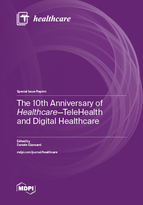The 10th Anniversary of Healthcare—TeleHealth and Digital Healthcare
A special issue of Healthcare (ISSN 2227-9032). This special issue belongs to the section "TeleHealth and Digital Healthcare".
Deadline for manuscript submissions: closed (31 October 2023) | Viewed by 34325
Special Issue Editor
Interests: biomedical engineering; robotics; artificial intelligence; digital health; rehabilitation; smart technology; cybersecurity; mental health; animal-assisted therapy; social robotics; acceptance; diagnostic pathology and radiology; medical imaging; patient safety; healthcare quality; health assessment; chronic disease
Special Issues, Collections and Topics in MDPI journals
Special Issue Information
Dear Colleagues,
The year 2023 will mark the 10th-anniversary volume of Healthcare (IF 3.160), and we would be thrilled if you could join us on this wonderful occasion.
Healthcare is an international, scientific, peer-reviewed, open access journal on healthcare systems, industries, technology, policy, and regulation. Published semi-monthly online by MDPI and with an Impact Factor of 3.160, this journal ranks in the Q2 in the classifications of Health Care Sciences & Services and Health Policy & Services research. Healthcare is without a doubt a rapidly developing journal.
In recognition of this significant milestone, we are launching a Special Issue entitled “The 10th Anniversary of Healthcare—TeleHealth and Digital Healthcare’.
The fields of TeleHealth and digital healthcare have seen wonderful developments in recent years thanks to the evolution of digitization processes, mobile and fixed technologies, and the standardization of integration processes in the health domain. The Covid-19 pandemic has represented a real training ground in this field and an unexpected growth stimulus never experienced before, with the consolidation of ancient areas and the exploration of new areas of use. Furthermore, today, even in TeleHealth and digital healthcare, one can count on the use of emerging technologies in areas such as robotics, augmented reality, virtual reality, and artificial intelligence. Even assistive technologies in use in some applications today have the opportunity to rely on this sector. The Special Issue, on the occasion of the 10th anniversary of Healthcare, aims to map present developments, reporting the consolidated experiences, the prospects and the remaining the challenges in this field.
This Special Issue invites researchers to include high-quality papers on topics within the field of healthcare. We will consider manuscripts that investigate TeleHealth and digital healthcare. Submissions may come in the form of either original research papers or comprehensive review articles.
Dr. Daniele Giansanti
Guest Editor
Manuscript Submission Information
Manuscripts should be submitted online at www.mdpi.com by registering and logging in to this website. Once you are registered, click here to go to the submission form. Manuscripts can be submitted until the deadline. All submissions that pass pre-check are peer-reviewed. Accepted papers will be published continuously in the journal (as soon as accepted) and will be listed together on the special issue website. Research articles, review articles as well as short communications are invited. For planned papers, a title and short abstract (about 100 words) can be sent to the Editorial Office for announcement on this website.
Submitted manuscripts should not have been published previously, nor be under consideration for publication elsewhere (except conference proceedings papers). All manuscripts are thoroughly refereed through a single-blind peer-review process. A guide for authors and other relevant information for submission of manuscripts is available on the Instructions for Authors page. Healthcare is an international peer-reviewed open access semimonthly journal published by MDPI.
Please visit the Instructions for Authors page before submitting a manuscript. The Article Processing Charge (APC) for publication in this open access journal is 2700 CHF (Swiss Francs). Submitted papers should be well formatted and use good English. Authors may use MDPI's English editing service prior to publication or during author revisions.
Keywords
- digital health
- TeleHealth
- robotics
- artificial intelligence
- mHealth
- rehabilitation
- assistive technologies
- eHealth
- smart technology
- cybersecurity
- informatics
- big data
- mental health
- telemedicine
- digital pathology
- digital radiology
- social robotics







